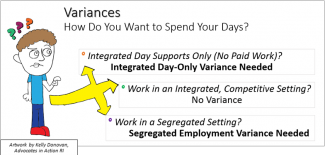Variance Information
What is a Variance?
A variance is official approval of something different from the usual expectations.
Under the “Employment First” guidelines, the usual expectations are:
- All people, no matter what disability they have, should have opportunities for real jobs with real wages, and work that matches their skills and interests.
- All people, with and without disabilities, can work together, in integrated work places in the community, earning minimum wage or higher.
Some individuals may choose not to work at all, or to work in a segregated setting. They would need a variance to document that they have made an informed choice not to work in integrated competitive employment.
There are 2 types of variances:
- Variance for Integrated Day Services Only
- Variance to Work in a Segregated Employment Setting

A copy of each variance request form can be found on our Forms webpage. You can print the forms, fill them out, and submit them as described in the Variance Submission and Review instructions.

Variances are not permanent. A variance does not remove the State’s obligation to offer an opportunity to work. A person with a variance may change their mind and choose employment in the future. If a person is not working in the community, this decision should be reviewed every year during an ISP review.
Each year during the ISP, employment goals should be discussed just like any other life goals someone may consider. If the person is happy with their decision not to work, that will be documented in the plan. Employment, or any other possible life goal, should always be available as an option.
Below are links to more information about variances.
- Variance Policy – the official policy about variances
- Variance FAQs – a list of frequently asked questions about the variances
- To fill-in a PDF application on your computer, you will need Adobe Reader software installed on your computer. There is no cost to install Adobe Reader.
A variance is not needed for retirement. Read the Retirement Policy for more details.